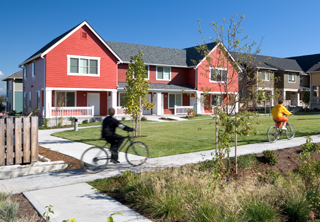
DJC.COM
February 14, 2008
When sustainability means putting people first
Mithun

Droge
|

Saleeba
|
Going “green” in building conjures up images of energy efficiency, strategic daylighting and reduced water consumption. Often overlooked is “building” healthier residents.
Green building strategies have typically addressed ecological and economic issues, which account for two sides of the “sustainability triad.” Increasingly, the third side — social equity or community — is being emphasized to promote the health of individuals within a designed community.
Health impact assessments (HIAs) are part of an emerging methodology that focuses on this component and expands the definition of green building.
Design and health
The goal of an HIA is to evaluate a policy or project’s potential effects on health. HIAs are research-based and promoted by public health offices and research institutions. Though relatively new in the United States, approximately 25 HIAs have been completed here in the past 10 years.
So what impact do HIAs have on green building? Research shows the components of the built environment (land-use patterns, access to mass transportation and urban design) can have a significant impact on human health even though many people fail to see the connection. The link between the built environment and our health is real.

Photo by Doug J Scott High Point, a mixed-income community in West Seattle, uses design to improve health with its access to mass transit and a network of roads, sidewalks, parks and services. |
The built environment can encourage or discourage physical activity. Children residing in an area that lacks sidewalks, bike paths, parks and nearby schools tend to be less physically active. Limited physical activity has been linked to health issues like obesity, diabetes, heart disease and depression.
Positive health outcomes are enhanced by mixed land uses that incorporate safe circulation patterns for pedestrians and bicyclists, as well as access to parks, schools, grocery stores and open-space networks.
Assessment types
HIAs tend to come in three sizes: rapid, intermediate and comprehensive. The type of HIA performed depends on a project’s potential health issues, as well as the time line for completion, the budget and the willingness of decision-makers to incorporate findings into the final project.
The intermediate HIA is perhaps the most frequently used approach. It entails reviewing literature of similar HIAs and provides detailed information of possible health impacts. The intermediate HIA can take several weeks or months to complete.
A rapid HIA may evaluate potential health impacts of an entire plaza or a single new building. Sometimes HIAs can be as simple as creating a “logic model” that communicates the relationship between the built environment and health impacts.
A complex development project could benefit from a comprehensive HIA. The San Francisco Department of Public Health has developed a useful checklist called the Healthy Development Measurement Tool, available online at http://www.thehdmt.org.
HIA findings offer their greatest value when reviewed during the pre-design, conceptual design, schematic design and design development phases.
It is critical to understand and value the basic health impacts of a proposal early so that essential aspects can be held sacred during the value-engineering process. Mithun is developing its own rapid HIA tool to keep potential health impacts in view as designs are developed.
To illustrate how an internal HIA melds design and health, one can look at High Point, a mixed-income community in West Seattle designed by Mithun and built by the Seattle Housing Authority.
Reducing travel
Research has shown a direct correlation between mixed land uses and a reduction in vehicle miles traveled.
Reduced travel contributes to cleaner air, fewer illnesses related to air pollution and fewer injuries caused by traffic accidents.
High Point is an example of how this finding can be applied to community design. Residents live in close proximity to schools, associated play fields, other civic services and employment opportunities.
Residents benefit from the network of sidewalks and roads to walk, bike or drive a short distance from their houses to nearby services. The arrangement of land uses and circulation patterns encourage physical activity while promoting reduced vehicle travel and related illness and injuries.
Importance of mass transit
High Point is located within an existing urban fabric, which allows for mass transit.
If High Point residents take the bus instead of using their vehicles, the walk to and from the bus stop will increase their physical activity and can improve overall cardiovascular and respiratory health. Mass transit availability is an important contributor in helping people meet the 30 minutes of exercise per day recommended by federal physical activity guidelines.
Focus on health
High Point’s 35 “Breathe Easy” homes are designed to help relieve symptoms of asthma for affected families. Features include hard-surface flooring, enhanced ventilation systems, and non-off-gassing materials and insulation designed to reduce dust, humidity and moisture.
HIAs are an important new green building tool based on evolving research. Although enumerating the health benefits or negatives of a proposed design sounds intuitive, HIA methodologies allow us to be explicit.
Green building experts must talk about the health impacts of planning and design proposals in order to make human health as visible as the ecological and financial health of the project.
If the goal of green building is to create a sustainable community, we should leverage every design and planning tool available to promote public health and wellbeing. As the definition of green building expands, so will the likelihood that residents will be as vibrant and sustainable as the buildings they occupy.
Martha Droge is an environmental planner and landscape architect at Mithun. Chris Saleeba is a landscape designer at Mithun.
Other Stories:
- Charrettes evolve to help make projects lean and green
- Vancouver convention center goes for the gold
- Affordable green housing: a social, economic priority
- Reduce your footprint, starting with where you work
- Tapping a market by building green
- Let’s get pumped up about heat sharing
- New LEED standards help retailers go green
- What does sustainability mean in practice?
- Rising to the challenge of carbon neutrality
- Dead-end street to get an urban makeover
- Is LEED living up to its hype?
- New headquarters lets firm walk the green talk
- How one city is getting greener
Copyright ©2009 Seattle Daily Journal and DJC.COM.
Comments? Questions? Contact us.